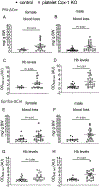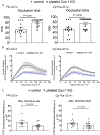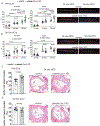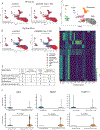Differential Impact In Vivo of Pf4-ΔCre-Mediated and Gp1ba-ΔCre-Mediated Depletion of Cyclooxygenase-1 in Platelets in Mice
- PMID: 38660804
- PMCID: PMC11138953
- DOI: 10.1161/ATVBAHA.123.320295
Differential Impact In Vivo of Pf4-ΔCre-Mediated and Gp1ba-ΔCre-Mediated Depletion of Cyclooxygenase-1 in Platelets in Mice
Abstract
Background: Low-dose aspirin is widely used for the secondary prevention of cardiovascular disease. The beneficial effects of low-dose aspirin are attributable to its inhibition of platelet Cox (cyclooxygenase)-1-derived thromboxane A2. Until recently, the use of the Pf4 (platelet factor 4) Cre has been the only genetic approach to generating megakaryocyte/platelet ablation of Cox-1 in mice. However, Pf4-ΔCre displays ectopic expression outside the megakaryocyte/platelet lineage, especially during inflammation. The use of the Gp1ba (glycoprotein 1bα) Cre promises a more specific, targeted approach.
Methods: To evaluate the role of Cox-1 in platelets, we crossed Pf4-ΔCre or Gp1ba-ΔCre mice with Cox-1flox/flox mice to generate platelet Cox-1-/- mice on normolipidemic and hyperlipidemic (Ldlr-/-; low-density lipoprotein receptor) backgrounds.
Results: Ex vivo platelet aggregation induced by arachidonic acid or adenosine diphosphate in platelet-rich plasma was inhibited to a similar extent in Pf4-ΔCre Cox-1-/-/Ldlr-/- and Gp1ba-ΔCre Cox-1-/-/Ldlr-/- mice. In a mouse model of tail injury, Pf4-ΔCre-mediated and Gp1ba-ΔCre-mediated deletions of Cox-1 were similarly efficient in suppressing platelet prostanoid biosynthesis. Experimental thrombogenesis and attendant blood loss were similar in both models. However, the impact on atherogenesis was divergent, being accelerated in the Pf4-ΔCre mice while restrained in the Gp1ba-ΔCres. In the former, accelerated atherogenesis was associated with greater suppression of PGI2 biosynthesis, a reduction in the lipopolysaccharide-evoked capacity to produce PGE2 (prostaglandin E) and PGD2 (prostanglandin D), activation of the inflammasome, elevated plasma levels of IL-1β (interleukin), reduced plasma levels of HDL-C (high-density lipoprotein receptor-cholesterol), and a reduction in the capacity for reverse cholesterol transport. By contrast, in the latter, plasma HDL-C and α-tocopherol were elevated, and MIP-1α (macrophage inflammatory protein-1α) and MCP-1 (monocyte chemoattractant protein 1) were reduced.
Conclusions: Both approaches to Cox-1 deletion similarly restrain thrombogenesis, but a differential impact on Cox-1-dependent prostanoid formation by the vasculature may contribute to an inflammatory phenotype and accelerated atherogenesis in Pf4-ΔCre mice.
Keywords: atherosclerosis; blood platelets; cyclooxygenase-1; hemostasis; thrombosis.
Conflict of interest statement
Figures




References
Publication types
MeSH terms
Substances
Grants and funding
LinkOut - more resources
Full Text Sources
Molecular Biology Databases
Research Materials
Miscellaneous

